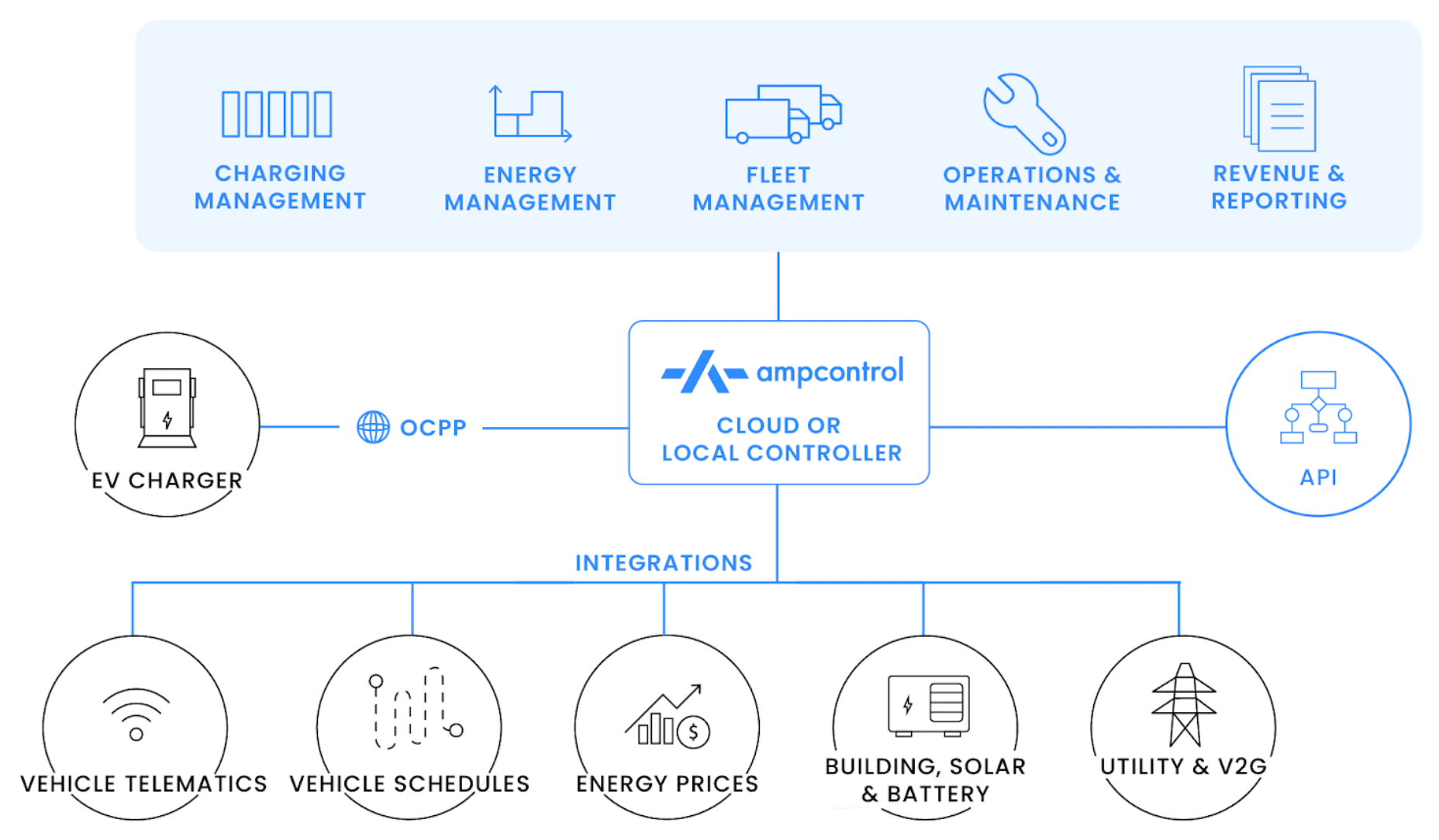

By
Joachim Lohse
July 31, 2025

As electric vehicle (EV) charging becomes a cornerstone of transportation infrastructure, the need for a reliable microgrid controller has never been greater. Fleet operators, distribution centers, and bus depots are increasingly turning to intelligent energy management solutions that integrate EV chargers into microgrids for efficiency, resilience, and cost control.
But what makes the best microgrid controller for these complex environments?
An advanced microgrid controller must seamlessly communicate with a variety of energy assets to ensure stable and efficient operations. For EV charging, this typically requires robust communication protocols such as Modbus TCP/IP, MQTT, SunSpec and OCPP—all critical for charger interoperability and real-time data exchange.
Beyond the microgrid itself, controllers also need to integrate with utility systems to receive real-time grid signals. This connectivity enables dynamic responses to changing conditions such as energy price fluctuations, demand response events, and grid constraints—essential features for modern intelligent energy management in distributed environments.
The type of data exchanged between assets and the central controller often includes setpoints, meter readings, on/off control signals, and other data requests. This creates a coordinated orchestration layer that optimizes energy flows across the entire microgrid.
While the concept seems straightforward, implementing and maintaining such a system is complex. It requires ultra-low response times and must continuously adapt to external variables such as solar generation variability, ambient temperature shifts, and the dynamic charging needs of electric vehicles. This makes the role of an intelligent microgrid controller indispensable for maintaining performance, reliability, and operational efficiency.

The choice between a site-based microgrid controller and a cloud-only energy management system has significant implications for performance.
Cybersecurity is another critical factor. While cloud and on-site systems can both be secure, local microgrid controllers behind firewalls reduce exposure to cyber threats compared to fully cloud-reliant systems. This makes them an attractive choice for operators managing sensitive infrastructure.
For fleet operators and charging station managers, complexity should remain behind the scenes. The best microgrid controllers provide a “set-it-and-forget-it” energy management experience, automating load balancing, cost optimization, and EV departure scheduling while offering intuitive dashboards for visibility.
This philosophy drove Ampcontrol to develop the AmpEdge Controller—a controller specifically designed for EV-integrated microgrids. Deployed for over two years, the AmpEdge Controller enables:
Ampcontrol’s AI-powered platform provides the advanced tools we need to efficiently optimize and monitor our EV charging infrastructure. Their vision closely aligns with ours, and we’re excited to partner with them.
Ihor Starepravo, Head of Software at WattEV
When selecting a microgrid controller for EV charging depots and fleet operations, it’s important to understand how different solutions stack up. Here’s how AmpEdge compares to other leading platforms:
AmpEdge is purpose-built for fleet charging depots, combining:
With nearly a decade of experience in EV charging–specific energy applications, Ampcontrol has established the AmpEdge controller as one of the leading standards for EV charging hubs across logistics centers, bus operations, ports, and other large-scale charging depots.
AmpEdge is purpose-built for fleet charging depots, addressing the limitations seen in other solutions. Unlike cloud-only or grid-scale controllers, AmpEdge combines on-site control for ultra-low-latency operations with cloud connectivity for advanced analytics, reporting, and remote oversight. It supports OCPP integration, enabling seamless charger management, while also coordinating battery, solar, and grid resources for optimal cost and load balancing. This makes AmpEdge uniquely suited for complex environments such as warehouses, last-mile delivery depots, bus terminals, and DC fast-charging hubs, where reliability, flexibility, and intelligent energy management are critical.

EV charging depots and hubs—whether equipped with a large number of AC chargers or multiple high-powered DC chargers—must carefully consider microgrid installations. This is particularly critical when chargers are deployed at existing facilities such as warehouses, distribution centers, or fleet depots, where grid capacity is often limited yet the need for substantial charging infrastructure is high.
In these environments, intelligent microgrid controllers like the AmpEdge provide the flexibility and efficiency needed to balance energy demands. Key use cases include:
As EV infrastructure continues to scale, adopting advanced microgrid controllers will become essential for ensuring operational resilience, cost-effective energy management, and seamless EV charging across diverse site types.

Ampcontrol is a cloud-based software that seamlessly connects to charging networks, vehicles, fleet systems, and other software systems. No hardware needed, just a one-time integration.